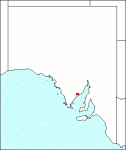Family: Fabaceae
Acacia praemorsa

Citation:
P. Lang & B. Maslin, J. Adelaide Bot. Gard. 13:118-123 (1990).
Derivation: praemorsus (L.)—bitten at the end, as if the end of the phyllode was bitten off.
Synonymy: Not Applicable Common name: None
Description:
A shrub 1-2 (-3) m tall, erect, glabrous, suckering. Branchlets and smaller twigs with angular lines commencing below each phyllode. Stipules narrowly triangular to 1.4 mm long, mostly caducous sometimes persistent.
Phyllodes linear, 2-9cm long, l.5-2.5mm wide, flattened, slightly to strongly incurved, soft and flexible, 1-veined with a single vein submerged and not readily visible, some longitudinal wrinkling on drying, apex obliquely terminated by brown resinous gland flanked by two minute stipule-like appendages and exceeded by an eccentric incurved, swollen, short, mucro; basal gland on upper margin, 6-18 mm above the pulvinus.
Inflorescence 1 or rarely 2 reduced racemes per node, 1.5-3.5 mm long. Peduncles 6-12 mm long, glabrous, basal bract solitary and covering young heads. Flower-heads globular, 34-50-flowered, bright lemon yellow, 7.5-9.5 mm diam. Flowers 5-merous.
Legumes linear, straight or slightly curved, flat or twisted, to 13 cm long, 5-8.5 mm wide glabrous, somewhat raised over the seeds and constricted between them. Seeds longitudinal 4.5-6.5 mm long, 3-4 mm wide, aril off-white, extending about half the length of the seed, funicle straight, flat, short.
|
|
Distribution:
|
Confined and extremely localised on north-eastern Eyre Peninsula. Found in loamy soils amongst rocks on lower slopes of gullies. Growing with Melaleuca uncinata, Acacia calamifolia (sp. 21), Eucalyptus odorata and other mallee Eucalypts.
S.Aust.: EP.
|
Conservation status:
Lang considers this species to be Rare but Conserved. Only four populations are known, one is adjacent to Yeldulknie Conservation Park, wherein it is expected to occur and a second population is covered by a Heritage Agreement.
Flowering time: There are few examples, but it has been found in flower and fruit in October and again in December.
|

SA Distribution Map based
on current data relating to
specimens held in the
State Herbarium of South Australia
|
Biology:
No text
Taxonomic notes:
This rare species was first collected in 1986 and none of the known populations can be reached by road. A. praemorsa is an unusual species with its seemingly veinless truncated phyllodes. In the field it bears a striking resemblance to Senna artemisioides ssp. petiolaris (=Cassia nemophila var. platypoda) that have shed their terminal leaflets as often happens under harsh conditions. Despite a superficial resemblance to A. nematophylla (sp. 22) and A. calarnifolia (sp. 21) A. praemorsa belongs to the A. microcarpa (sp. 17) complex, i.e. A, acinacea (sp. 6), A. irnbricata (sp. 1 O) and A. triquetra (sp. 11). However it differs from members of the A. microcarpa complex in its linear to narrow linear phyllodes, submerged vein, raceme axes to 3.5 mm, more numerous flowers per head and punctulate seeds. A distinctive feature is the minute claw-like appendages flanking the terminal gland which has now been found on A. microcarpa in young growths from which they are often lost as the phyllode expands. Terminal glands are also uncommon in this section of Acacia but do occur in A. victoriae (sp. 13) and a few other species.
Cultivation:
Not yet known in cultivation.
Author:
Not yet available
Source:

|

